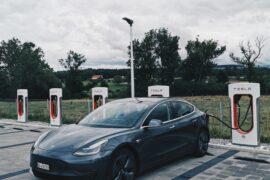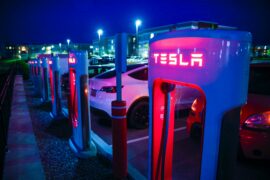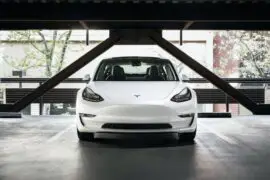The Volkswagen ID.4 is an all-electric SUV that has quickly made a name for itself in the growing electric vehicle market. With a spacious interior, impressive range, and eco-friendly design, the ID.4 has become a popular choice for drivers who want to reduce their carbon footprint without sacrificing comfort or performance.
One of the key factors that make electric vehicles like the ID.4 so appealing is their charging system, and specifically, the “charge curve” that determines how quickly the battery can be charged. Understanding the charge curve is essential for maximizing the efficiency and convenience of an electric vehicle.

In this article, we will delve into the ID.4 charge curve, exploring what it is, how it works, and why it matters. We’ll look at the various factors that can affect the ID.4’s charging rate, as well as the benefits and limitations of its fast-charging system. By the end of this article, you’ll better understand how the ID.4’s charging system can impact your driving experience and how to optimize its performance for your needs.
Contents
Understanding the ID.4 Charge Curve
Electric vehicles, such as the Volkswagen ID.4, rely on a battery to power their motors. Just like any other battery, electric vehicle batteries need to be charged periodically to provide power for driving. The “charge curve” refers to the rate at which the battery is charged during the charging process.
A charge curve typically shows the relationship between the battery’s state of charge (SOC) and the time or power required to reach that SOC. The curve typically has a bell-shaped curve, with a fast charging rate at the beginning of the charging process and then a gradually decreasing charging rate as the battery approaches full charge.
The charge curve for ID.4 is determined by several factors, such as the battery’s capacity, the type of charging station being used, and the vehicle’s charging software. Volkswagen has optimized the ID.4’s charging system to provide a fast and efficient charging experience while also considering the battery’s long-term health.
Optimizing the charge curve is crucial for maximizing the vehicle’s performance. If the battery is charged too quickly, it can become overheated, damaging the battery and shortening its lifespan. On the other hand, if the battery is charged too slowly, it can waste time and energy. By optimizing the charge curve, the ID.4 can provide a balance between fast charging and battery health, ensuring that drivers can enjoy a reliable and efficient driving experience.

Factors That Affect the ID.4 Charge Curve
- Ambient temperature: The temperature of the environment in which the ID.4 is charging can have a significant impact on the charging rate. Cold temperatures can slow down the charging rate, while hot temperatures can cause the battery to overheat, which can damage the battery and reduce its lifespan.
- Battery state: The state of the battery, including its age, health, and charge level, can also impact the charging rate. For example, if the battery is already partially charged, it may charge more slowly as it approaches full capacity.
- Charging station type: The type of charging station being used can also affect the charging rate. Level 1 charging stations, which typically use a standard 120-volt household outlet, charge the ID.4 slowly. Level 2 charging stations, which use a 240-volt outlet, provide faster charging rates. DC fast chargers, which are the fastest type of charging station available, can charge the ID.4 up to 80% in just 38 minutes.
Each of these factors can affect ID.4’s charging rate and charge curve in different ways. For example, if the temperature is very cold, the battery may need to warm up before it can charge efficiently, which can slow down the charging rate. Alternatively, if the battery is already partially charged, the charging rate may decrease as the battery approaches full capacity.
Here are some examples of how different scenarios can impact the charging rate of the ID.4:
- If the ID.4 is charging on a hot day, the battery may start charging quickly, but as it approaches full capacity, the charging rate may slow down to avoid overheating the battery.
- If the ID.4 is charging on a cold day, the charging rate may start off slower than usual, as the battery needs to warm up before it can charge efficiently.
- If the ID.4 is charging on a Level 1 charging station, the charging rate will be slower than if it were charging on a Level 2 or DC fast charger.
The Fast-Charging System of the ID.4
The Volkswagen ID.4 features a fast-charging system that allows the battery to be charged up to 80% in just 38 minutes using a DC fast charger. This is made possible by the ID.4’s high-voltage battery system, which has a capacity of up to 82 kWh, and the vehicle’s advanced charging software, which is designed to optimize the charging experience.
The fast-charging system affects the ID.4’s charge curve by providing a higher charging rate at the beginning of the charging process and then gradually reducing the charging rate as the battery approaches full capacity. This ensures that the battery is charged quickly and efficiently while also protecting the battery from overheating or other damage that can occur with high-speed charging.
One of the main benefits of the fast-charging system is that it allows drivers to quickly recharge their ID.4 on long road trips or other extended driving scenarios. With a fast charger, drivers can easily add significant range to the vehicle in a relatively short amount of time, making it more convenient and practical for everyday use.
However, there are also some limitations to the fast-charging system. For example, fast charging can reduce the overall lifespan of the battery, especially if it is used frequently or at high power levels. Additionally, not all charging stations are capable of providing fast DC charging, so drivers may need to plan their trips carefully to ensure they have access to the right type of charging station.

So, What is ID.4 charge curve?
In summary, understanding the charge curve is essential for electric vehicle drivers, as it impacts the vehicle’s performance and efficiency. The Volkswagen ID.4 has an optimized charging system that takes into account various factors, such as temperature and battery state, to ensure fast and efficient charging. The ID.4’s fast-charging system also provides drivers with the convenience of adding significant range in a short amount of time.
For those interested in purchasing or using an ID.4, it’s important to consider factors such as the availability of charging stations and the frequency of long road trips. However, with its advanced charging technology and other features, the ID.4 is a practical and reliable option for electric vehicle drivers.
Want to know about Trucks with bench seats? Read it here.





